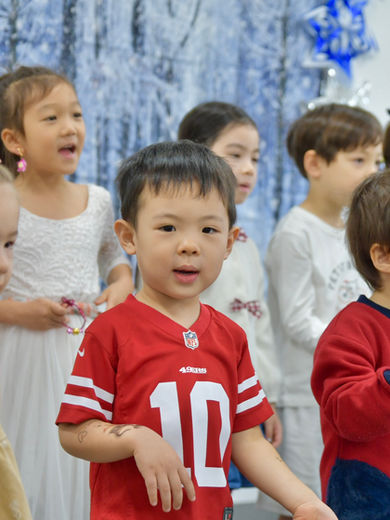Our Sunshine programme, for children aged 3 to 6, is a vibrant environment where you’ll see children counting beads, collaborating on a puzzle map, or participating in a new language activity with a teacher. Sunshine classrooms provide the freedom to explore within clear limits, fostering concentration and self-regulation. This dynamic setting nurtures their development across practical life skills, sensory refinement, language, mathematics, and cultural awareness.
When you walk into our Sunshine classrooms, the first thing you will notice is that everyone is busy and interested in what they are doing.
One child is counting beads, others are working together on a puzzle map, and in the corner of the room a teacher is introducing a small group of children to a new language activity. Our Sunshine classrooms give the children the freedom to work within clear limits while developing their concentration and self-regulation.
The Sunshine curriculum is grouped into 5 areas:
Practical Life
The foundation for all further work, allowing the child to develop gross motor and fine motor skills, confidence, self-esteem, independence and concentration. These activities also develop practical skills to help the child become a contributing member of the group by helping to maintain their classroom environment.
Sensorial
Activities in this area help the child to develop and refine the senses through specially designed materials which isolate one sense such as sight or hearing.
Language
This is an extremely important time for language development so communication is always encouraged. Phonetic sounds are learned, leading initially to word formation and later to an "explosion" of writing. Reading takes place first by matching picture cards to words. Children love to learn about grammar (verbs, nouns and adjectives). In addition, we have one Japanese speaking teacher in each Sunshine classroom. Children are exposed to Japanese songs and are introduced to different aspects of Japanese culture. Oral communication is emphasized and children learn some basic expressions. Where appropriate, hiragana (a phonetic Japanese alphabet) is introduced to students.
Mathematics
Learning mathematics at this age is not repetitive rote learning. Children love to learn the quantities and symbols for numbers even into the thousands. Names of geometric shapes and solids roll off the tongues of three and four year olds, while others learn addition, subtraction, multiplication and division sensorially with the decimal system and fractions.
Culture
Geography, history, the sciences, art, and music are all covered using tangible materials which the child manipulates. As an international school, whose faculty and student body represent many different cultures around the world, we are able to offer personal insights into life in other places. Children enjoy listening to a teacher or parent of a child from a different country describe life and customs from that country.
For a more detailed look at our curriculum:
































